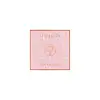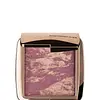What's inside
What's inside
 Key Ingredients
Key Ingredients

 Benefits
Benefits

No benefits
 Concerns
Concerns

 Ingredients Side-by-side
Ingredients Side-by-side

Mica
Cosmetic ColorantTalc
AbrasiveSynthetic Fluorphlogopite
Magnesium Stearate
Cosmetic ColorantCalcium Sodium Borosilicate
Boron Nitride
AbsorbentPolyethylene
AbrasiveCaprylic/Capric Triglyceride
MaskingEthylhexyl Palmitate
EmollientSilica
AbrasiveHdi/Trimethylol Hexyllactone Crosspolymer
Polyisobutene
Isododecane
EmollientTriethoxycaprylylsilane
Dimethicone
EmollientCocos Nucifera Oil
MaskingBis-Diglyceryl Polyacyladipate-2
EmollientPhenoxyethanol
PreservativeTin Oxide
AbrasiveEthylhexylglycerin
Skin ConditioningCI 77891
Cosmetic ColorantCI 77491
Cosmetic ColorantCI 16035
Cosmetic ColorantCI 15850
Cosmetic ColorantMica, Talc, Synthetic Fluorphlogopite, Magnesium Stearate, Calcium Sodium Borosilicate, Boron Nitride, Polyethylene, Caprylic/Capric Triglyceride, Ethylhexyl Palmitate, Silica, Hdi/Trimethylol Hexyllactone Crosspolymer, Polyisobutene, Isododecane, Triethoxycaprylylsilane, Dimethicone, Cocos Nucifera Oil, Bis-Diglyceryl Polyacyladipate-2, Phenoxyethanol, Tin Oxide, Ethylhexylglycerin, CI 77891, CI 77491, CI 16035, CI 15850
Mica
Cosmetic ColorantSynthetic Fluorphlogopite
Boron Nitride
AbsorbentHdi/Trimethylol Hexyllactone Crosspolymer
Polymethyl Methacrylate
Octyldodecanol
EmollientCalcium Sodium Borosilicate
Alumina
AbrasiveBenzoic Acid
MaskingC13-14 Isoparaffin
EmollientDehydroacetic Acid
PreservativeDiamond Powder
AbrasiveDimethicone
EmollientEthylhexylglycerin
Skin ConditioningLaureth-7
EmulsifyingMagnesium Aluminum Silicate
AbsorbentPhenoxyethanol
PreservativePolyacrylamide
Polymethylsilsesquioxane
Potassium Sorbate
PreservativeSilica
AbrasiveSodium Dehydroacetate
PreservativeSorbic Acid
PreservativeSorbitan Sesquioleate
EmulsifyingTin Oxide
AbrasiveTrimethylsiloxysilicate
EmollientCI 15850
Cosmetic ColorantCI 77007
Cosmetic ColorantCI 77163
Cosmetic ColorantIron Oxides
CI 77891
Cosmetic ColorantMica, Synthetic Fluorphlogopite, Boron Nitride, Hdi/Trimethylol Hexyllactone Crosspolymer, Polymethyl Methacrylate, Octyldodecanol, Calcium Sodium Borosilicate, Alumina, Benzoic Acid, C13-14 Isoparaffin, Dehydroacetic Acid, Diamond Powder, Dimethicone, Ethylhexylglycerin, Laureth-7, Magnesium Aluminum Silicate, Phenoxyethanol, Polyacrylamide, Polymethylsilsesquioxane, Potassium Sorbate, Silica, Sodium Dehydroacetate, Sorbic Acid, Sorbitan Sesquioleate, Tin Oxide, Trimethylsiloxysilicate, CI 15850, CI 77007, CI 77163, Iron Oxides, CI 77891
Ingredients Explained
These ingredients are found in both products.
Ingredients higher up in an ingredient list are typically present in a larger amount.
Boron Nitride is compound consisting of boron and nitrogen. It is used to absorb oil and modify adherence/ slip in products.
This means it is often used in makeup products to help them last longer.
Calcium Sodium Borosilicate is a bulking agent. It is considered a borosilicate glass; it is composed of powder or flakes of calcium and sodium borosilicates.
This ingredient is used to add volume, shine, and color to products. You'll most likely find this ingredient in makeup products.
According to in-vivo and ex-vivo studies done by a manufacturer, this ingredient works well with UV filters:
Learn more about Calcium Sodium BorosilicateCi 15850 is the pigment color red. It is an azo dye and created synthetically.
Azo dyes need to be thoroughly purified before use. This allows them to be more stable and longer-lasting.
This ingredient is common in foundations, lipsticks, and blushes. This color is described as brown/orangey red.
It has many secondary names such as Red 6 and Red 7. According to a manufacturer, Red 6 usually contains aluminum.
Learn more about CI 15850Ci 77891 is a white pigment from Titanium dioxide. It is naturally found in minerals such as rutile and ilmenite.
It's main function is to add a white color to cosmetics. It can also be mixed with other colors to create different shades.
Ci 77891 is commonly found in sunscreens due to its ability to block UV rays.
Learn more about CI 77891Dimethicone is a type of synthetic silicone created from natural materials such as quartz.
What it does:
Dimethicone comes in different viscosities:
Depending on the viscosity, dimethicone has different properties.
Ingredients lists don't always show which type is used, so we recommend reaching out to the brand if you have questions about the viscosity.
This ingredient is unlikely to cause irritation because it does not get absorbed into skin. However, people with silicone allergies should be careful about using this ingredient.
Note: Dimethicone may contribute to pilling. This is because it is not oil or water soluble, so pilling may occur when layered with products. When mixed with heavy oils in a formula, the outcome is also quite greasy.
Learn more about DimethiconeEthylhexylglycerin (we can't pronounce this either) is commonly used as a preservative and skin softener. It is derived from glyceryl.
You might see Ethylhexylglycerin often paired with other preservatives such as phenoxyethanol. Ethylhexylglycerin has been found to increase the effectiveness of these other preservatives.
This ingredient is a powder used to improve texture, slip, and give products a silky texture.
Mica is a naturally occurring mineral used to add shimmer and color in cosmetics. It can also help improve the texture of a product or give it an opaque, white/silver color.
Serecite is the name for very fine but ragged grains of mica.
This ingredient is often coated with metal oxides like titanium dioxide. Trace amounts of heavy metals may be found in mica, but these metals are not harmful in our personal products.
Mica has been used since prehistoric times throughout the world. Ancient Egyptian, Indian, Greek, Roman, Aztec, and Chinese civilizations have used mica.
Learn more about MicaPhenoxyethanol is a preservative that has germicide, antimicrobial, and aromatic properties. Studies show that phenoxyethanol can prevent microbial growth. By itself, it has a scent that is similar to that of a rose.
It's often used in formulations along with Caprylyl Glycol to preserve the shelf life of products.
Silica, also known as silicon dioxide, is a naturally occurring mineral. It is used as a fine, spherical, and porous powder in cosmetics.
Though it has exfoliant properties, the function of silica varies depending on the product.
The unique structure of silica enhances the spreadability and adds smoothness, making it a great texture enhancer.
It is also used as an active carrier, emulsifier, and mattifier due to its ability to absorb excess oil.
In some products, tiny microneedles called spicules are made from silica or hydrolyzed sponge. When you rub them in, they lightly polish away dead skin layers and enhance the penetration of active ingredients.
Learn more about SilicaSynthetic Fluorphlogopite is the synthethic version of mica. It consists of fluorine, aluminum and silicate.
Synthetic Fluorphlogopite is used to add volume to products.
It is considered non-irritating on the skin.
Learn more about Synthetic FluorphlogopiteTin Oxide is an inorganic oxide used to add opacity and volume to a product. In nature, it is already found in mineral form. The main ore of tin is an opaque and shiny mineral called casseterite.
Tin Oxide helps remove translucency in a product, or make it more opaque. Besides adding opacity, tin oxide is used for bulking to add volume.